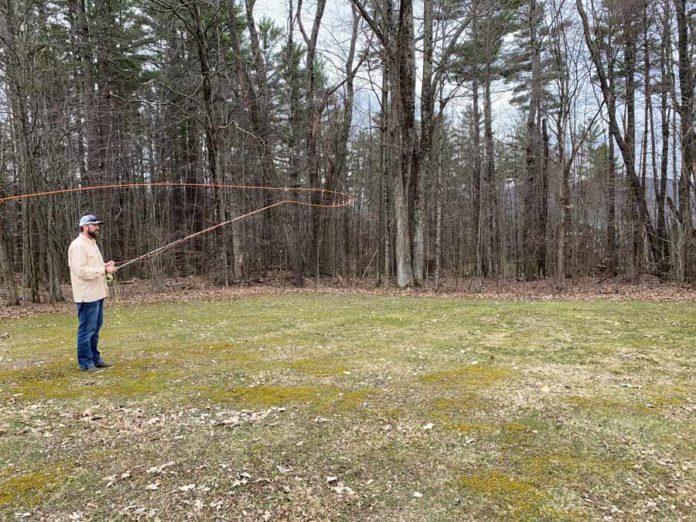Written by: Caitie Caroleo, Orvis Adventures Marketing Specialist
Welcome to a new series of how-to posts called “Home School with Pete Kutzer.” For most of us, winter means less time on the water and more time at home. If you’re like us, you may find some solace in thinking about adventures to come–what you want to do, where you want to go, and how you can prepare for future on-the-water experiences now.
For almost two decades, Orvis Fly-Fishing Instructor and Endorsed Operations Manager Pete Kutzer has taught at Orvis Schools–including at our flagship fly-fishing school in Manchester, Vermont, and specialty schools around the US and abroad. Pete was due to be instructing a Steelhead School at Alaska’s Boardwalk Lodge this month, but like the rest of us, he is now focused on more local opportunities.
In this first installation of Home School with Pete Kutzer, I asked Pete for suggestions on how to have some fun practicing the foundational elements of your cast while at home, even when your space is limited.
Q: Pete! What can I work on while I’m home?
Start with the basics. If you can get outside, work on your short game: casts of 20 to 30 feet.

Break the cast down by dividing your casting motion into a very distinct forward cast and back cast, which lets you focus on each piece of the puzzle more directly. The easiest way to make this happen is to cast at a side-arm angle.
- Make a forward cast, let it lie on the ground.
- Check to see if it’s landing straight.
- Gather yourself and then make a backcast at that same side-arm angle, watching the loop unroll all the way back.
- Check to see if the line lands straight.
- Make the next forward cast and repeat the process.
- Only after these two pieces feel pretty good and are landing nicely, link them together. Instead of letting your backcast hit the ground, start your forward cast after the line straightens out in the air. Let the forward cast land on the ground and see your results.
Q: What if someone doesn’t have access to a large enough (or any) spot outdoors?
You can still break your cast down. A great tool for indoor practice (and some fun skill-building in general) is a Practicaster. If you don’t have access to one, you can make your own version by using the tip portion of your fly rod and adding about 5 ft of fly line with a short 5 ft leader and a bit of yarn or something light attached to the end. Instead of a 20- to 30-foot cast, you’re working with a 3- to 4-foot cast, but the mechanics are very similar. Bonus points if you can get the kids or the pets involved in the fun, too.
If you need a good refresher on basic casting techniques, you can check out this great video:
Q: Any suggestions for other ways to stay engaged
indoors?
Absolutely! Making sure you’re really comfortable with a few important knots is a great way to spend some down time. I’d suggesting working on the improved clinch knot and triple surgeon’s to start. Commit them to memory, since they’ll be two knots you rely heavily on. The improved clinch is used to tie-on a fly, and the triple surgeon’s enables you to add tippet to your leader.
Begin practicing knots by starting with larger hooks and heavier tippets, which are easier to work with. Once you start to feel comfortable, move to smaller hooks and tippet. If you really want to round-out the experience, fill your bathtub with cold water and stand in it while tying your knots. Knot-tying may seem less interesting than casting, but you’ll be glad you put in the practice time when you need to tie these knots quickly on the water.

Since Pete was clearly enjoying being in teacher mode, we asked him he is most looking forward to when the fly-fishing schools get going again:
The things I’m most looking forward to are the people and the reactions they have when learning something new. When someone’s eyes light up and they say, “I think I got it!” is so cool. Also, I would be lying if I didn’t say I can’t wait to get back on the water with friends.
Caitie Caroleo is the Orvis Adventures Marketing Specialist, based at our Vermont headquarters.
Credit: Source link





























